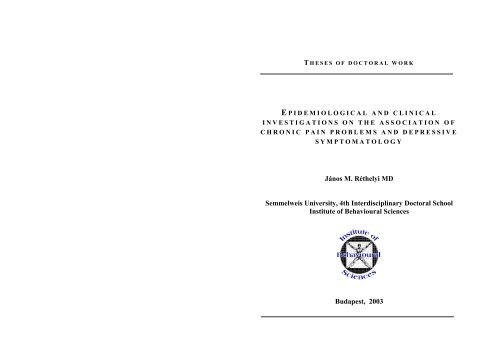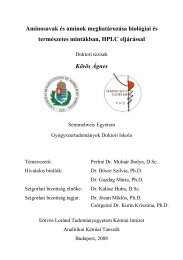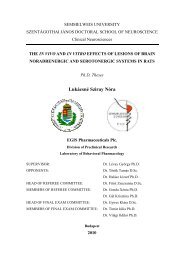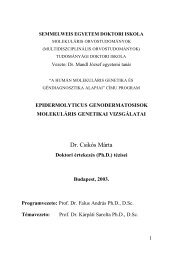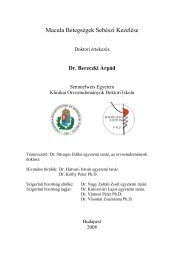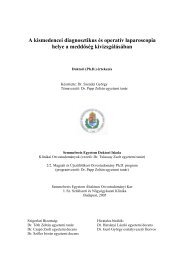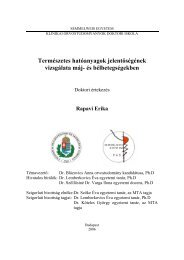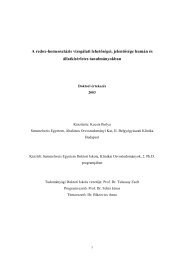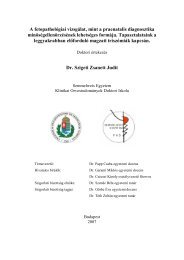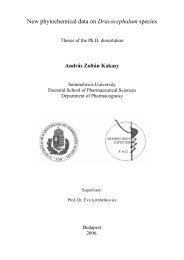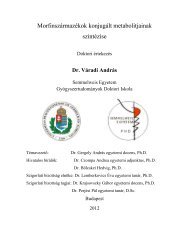János M. Réthelyi MD Semmelweis University, 4th Interdisciplinary ...
János M. Réthelyi MD Semmelweis University, 4th Interdisciplinary ...
János M. Réthelyi MD Semmelweis University, 4th Interdisciplinary ...
Create successful ePaper yourself
Turn your PDF publications into a flip-book with our unique Google optimized e-Paper software.
T HESES OF DOCTORAL WORK<br />
E PIDEMIOLOGICAL AND CLINICAL<br />
INVESTIGATIONS ON THE ASSOCIATION OF<br />
CHRONIC PAIN PROBLEMS AND DEPRESSIVE<br />
SYMPTOMATOLOGY<br />
<strong>János</strong> M. <strong>Réthelyi</strong> <strong>MD</strong><br />
<strong>Semmelweis</strong> <strong>University</strong>, <strong>4th</strong> <strong>Interdisciplinary</strong> Doctoral School<br />
Institute of Behavioural Sciences<br />
Budapest, 2003
T HESES OF DOCTORAL WORK<br />
E PIDEMIOLOGICAL AND CLINICAL<br />
INVESTIGATIONS ON THE ASSOCIATION OF<br />
CHRONIC PAIN PROBLEMS AND DEPRESSIVE<br />
SYMPTOMATOLOGY<br />
<strong>János</strong> M. <strong>Réthelyi</strong> <strong>MD</strong><br />
<strong>Semmelweis</strong> <strong>University</strong>, <strong>4th</strong> <strong>Interdisciplinary</strong> Doctoral School<br />
Institute of Behavioural Sciences<br />
Budapest, 2003
INTRODUCTION<br />
The epidemiology of pain has attracted wide interest in the last two<br />
decades and a vast amount of information has been collected concerning<br />
the topic. All of these investigations have come to the conclusion that<br />
chronic pain symptoms add up to a major challenge in public health as the<br />
source of individual suffering and considerable health-care costs. By<br />
comparing results from different parts of the world we may conclude, that<br />
20-51 % of the population is affected by severe chronic pain problems, and<br />
30-61 % is affected by middle grade pain problems. The prevalence of<br />
pain-associated disability is estimated in the range of 10-20%.<br />
Our other starting point besides the epidemiology of chronic pain is<br />
the association of chronic pain and depression, their comorbidity. This<br />
phenomenon apparent between experimental, clinical, and epidemiological<br />
circumstances as well is an important feature of the affective dimensions of<br />
pain, primarily the chronic forms. From a theoretical perspective the<br />
association between pain and depression might be defined at three levels:<br />
neurobiological (neurotransmitters, common pathways), psychological,<br />
and behavioral. At the neurobiological level, the neurotransmitters found to<br />
play a role in depression (serotonine and noradrenaline) have also been<br />
shown to modulate pain perception. At the level of psychological<br />
mechanisms, negative emotions worsen the perception of the severity of<br />
pain symptoms. At the behavioral level the decreased activity and<br />
disability caused by chronic pain may cause depression, which might be<br />
seen as a form of learned helplessness.<br />
National health surveys have diverse objectives; they serve<br />
information about the most important health problems to the specialists,<br />
decision makers and the general population. Information about risk factors,<br />
and possible health services in connection to health problems can also be<br />
distributed. These data help in assessing morbidity trends, the distribution<br />
of risk factors in the population, and the utilization of health services.<br />
Surveys can also be the starting point of focused clinical investigations.<br />
OBJECTIVES OF THE RESEARCH<br />
The primary objective of the research was the assessment of the<br />
comorbidity of chronic pain problems and depressive symptomatology in<br />
epidemiological and clinical samples. According to our hypothesis we<br />
predicted higher prevalence of co-occurring depressive symptomatology in<br />
groups of higher age, lesser educational level, and the employment groups<br />
of physical workers.<br />
During the investigation and analyses the following questions were<br />
postulated as objectives of the research:<br />
1. What is the prevalence of chronic pain problems in the investigated<br />
population samples? What is the prevalence of chronic pain-associated<br />
disability in the same samples?
2. What is the co-prevalence of depressive symptomatology in the<br />
subjects reporting chronic pain problems?<br />
3. Which sociodemographic factors increase the risk of chronic pain<br />
problems and the comorbidity of chronic pain problems and<br />
depression?<br />
4. In the clinical group of patients with depression what is the prevalence<br />
of pain problems?<br />
5. What factors play a role in the development of pain problems among<br />
depressed patients?<br />
6. In the group of patients with musculoskeletal diseases what is the<br />
prevalence of depressive symptomatology?<br />
7. How can our epidemiological results be used in the preventive and<br />
clinical services?<br />
METHODS<br />
HUNGAROSTUDY 1995 health survey<br />
The analyses and results are based on data from the<br />
HUNGAROSTUDY 1995 national representative survey that was carried<br />
out in the Hungarian population. The investigation included 12.640<br />
individuals above the age of 16 and was conducted by means of a door-todoor<br />
survey. The sample was composed by combining stratified and multistep<br />
sampling procedures.<br />
Chronic pain-associated disability was assessed together with the<br />
shortened form of the Beck Depression Inventory. Sociodemographic<br />
variables were tabulated as well. Results were analyzed as descriptive<br />
statistics, categorical variables were compared by means of the Chi-square<br />
test. Associations between sociodemographic variables and pain-associated<br />
disability and co-occurring depressive symptomatology were calculated by<br />
a multivariate logistic regression analysis.<br />
Young women’s health survey (1998)<br />
The framework of the study was the Young women’s health survey<br />
1998 as part of the Better Health for Women health promotion program<br />
organized by the Institute of Behavioural Sciences (Kopp, 1998). The<br />
sample of the cross-sectional survey included 3615 subjects and was a<br />
representative sample of the population of young women between 15-24<br />
years, selected by a multi-level stratified sampling method. The two major<br />
groups in the sample were young women still studying in secondary school<br />
or higher education institutions (2016 subjects) and the group of young<br />
women not studying anymore at the time of the survey (1599 subjects).<br />
In a list of other health complaints and symptoms interviewees were<br />
asked in the questionnaire whether they have frequently returning<br />
headaches and frequent musculoskeletal pain-problems. Possible answers
to these questions were yes or no. The rationale for choosing these<br />
variables was that headaches and musculoskeletal pain are unspecific<br />
symptoms that are leading types of chronic pain. Furthermore the<br />
shortened form of the Beck Depression Inventory was used to assess<br />
depressive symptomatology. Prevalence rates were calculated and were<br />
presented as descriptive statistics. Average depression scores were<br />
compared with the t-test based on not equal variances. Associations<br />
between sociodemographic variables and pain-associated disability and cooccurring<br />
depressive symptomatology were calculated by a multivariate<br />
logistic regression analysis.<br />
Follow-up study of depressive patients (1999)<br />
The follow-up study of the patients with depression was realized in<br />
cooperation with the Psychiatry Unit of the <strong>University</strong> Ulm, Germany. 91<br />
inpatients with an ICD-10 diagnosis of major depressive disorder were<br />
enrolled in the study (mean age 43,9 years, 47 females). The patients<br />
completed the pain-questionnaire after admission to the ward and 4-6<br />
months after discharge, which included questions on pain symptoms in<br />
terms of location, intensity, and frequency. The full-length version of the<br />
BDI was used to assess depressive symptomatology.<br />
Average pain intensity scores were compared with the t-test based<br />
on not equal variances.<br />
Clinical investigation of musculoskeletal patients (2001)<br />
This clinical investigation took place at the day Hospital National<br />
Institute of Rehabilitation (Budapest). The objective of the study was to<br />
assess the prevalence of depressive symptomatology in this patient group.<br />
57 patients (37 women and 20 men, mean age 50 years) were enrolled in<br />
the sample. The typical admission diagnoses were degenerative spine and<br />
small articular disease, osteoporosis, fibromyalgia, spondylitis<br />
ankylopoetica, Schauermann-disease, and scoliosis.<br />
The patients treated in the completed the full-length BDI after<br />
admission and before discharge. The cutoff scores for mild and moderate<br />
depression were determined as a score above 9 and 18. Admission and<br />
discharge scores were compared with the Mann-Whitney test.<br />
RESULTS<br />
HUNGAROSTUDY 1995 health survey<br />
The rate of interviewees reporting any grade of pain-associated<br />
disability was 32.7%. Further sub-groups were defined by gender and the<br />
different degrees of reported pain-associated disabilities. Furthermore<br />
15.1%, 12.3 %, and 5.0% of the population described pain symptoms as<br />
causing disabilities to a low , to a considerable , and to an extreme extent,<br />
respectively. Overall pain prevalence reported by women is significantly
higher than prevalence reported by men (36.8% and 27.7%, respectively),<br />
which remains statistically significant in the adjusted results (OR = 0.54;<br />
95% CI = 0.48-0.61). All age groups yielded statistically significant<br />
increasing rates of pain-associated disability with growing age.<br />
Comparisons depending on education, marital status, employment, and<br />
occupational status resulted in considerable differences observed as crude<br />
prevalence rates, however only the group of people holding a university<br />
degree (OR = 0.5; 95% CI = 0.3-0.9), widows (OR = 1.5; 95% CI = 0.1.5-<br />
2.1), and unskilled workers (OR = 1.4; 95% CI = 1.1-1.9) showed<br />
statistically significant different prevalence rates of pain-associated<br />
disability. In general, prevalence of pain-associated disability was higher<br />
among groups with lower educational background, or working as skilled or<br />
unskilled workers.<br />
The prevalence of moderate or severe depressive symptomatology<br />
was 13.4% in the whole sample. If the group reporting pain-associated<br />
disability was selected, the proportion with moderate or severe depressive<br />
symptoms was 30.2%. The co-prevalence of depressive symptomatology<br />
did not differ statistically significantly in women and men, what is<br />
reflected also by the equal odds ratios. Age groups yielded an increasing<br />
tendency with higher age, which was statistically significant in the age<br />
groups of 30-39 years (OR = 2.1; 95% CI = 1.3-3.4), of 60-69 years (OR<br />
= 2.0; 95% CI = 1.1-3.8), and over 70 years (OR = 3.0; 95% CI = 1.5-6.1).<br />
The prevalence of depressive symptomatology decreased with rising levels<br />
of education, the differences were statistically significant in the groups<br />
holding a secondary school (OR = 0.5; 95% CI = 0.3-0.8), or a university<br />
degree (OR = 0.4; 95% CI = 0.2-0.9). It is noteworthy that the groups of<br />
unemployed people (OR = 6.1; 95% CI = 1.3-20.4), skilled (OR = 2.0;<br />
95% CI = 1.3-4.5), and unskilled workers (OR = 2.4; 95% CI = 1.3-4.5)<br />
also reported significant co-prevalence rates of depressive<br />
symptomatology.<br />
Young women’s health survey (1998)<br />
The overall prevalence of frequent headaches and musculoskeletal<br />
pain-problems was 43.8%, and 25.8%, respectively. If the groups of<br />
students and non-students were investigated separately non specificheadaches<br />
yielded prevalence rates of 47.4% in students, and 45.5% in<br />
non-students, musculoskeletal problems yielded prevalence rates of 27.2%<br />
in students, and 23.9% in non-students.<br />
The rate of depressive symptomatology was more prevalent and<br />
higher in terms of intensity in the groups with pain problems. The intensity<br />
of depression was compared by the average of the corrected BDI score<br />
between groups with and without pain problems. The average score in the<br />
group reporting frequent headaches was 8.83 (SD=7.93) in contrast to the<br />
group without headaches, where the average score was 5.88 (SD=6.32)<br />
(t=11.824; df=2980.742; p
score of 6.68 (SD=6.85) in the group without musculoskeletal pain<br />
problems (t=6.757; df=1324.096; p
According to the multivariate analyses disabling pain problems show<br />
an increasing tendency and higher risk in women, with lower education<br />
and occupational levels.<br />
Our results indicate that the risk of co-occurring depressive<br />
symptoms is highly elevated in groups of lower educational level, in the<br />
group of unemployed, and at higher age.<br />
The main result of the follow-up study of depressed patients is that<br />
while the intensity of the depressive symptoms decreased, the pain<br />
problems remained at the time of the follow-up. This result must be<br />
corroborated by other studies, but the importance of the finding must be<br />
stressed. In the other clinical investigation 57% of patients showed at least<br />
mild depressive symptomatology, and in the case of 10% the diagnosis of a<br />
major depression can be hypothesized, according to the newest validityresults<br />
of the BDI.<br />
In the light of the above findings, we propose the implementation of results<br />
in four areas:<br />
Based on the association of chronic pain problems and<br />
musculoskeletal diseases all measures of health promotion and social<br />
marketing must be used to prevent musculoskeltal diseases. The social<br />
gradient observable in chronic pain-problems draws attention to accessproblems<br />
(1).<br />
At the meso-level the results on chronic pain-associate disability<br />
underscore the importance of workplace health promotion and<br />
rehabilitation. This issue is further stressed by the higher prevalence rates<br />
and odds ratios for disability in the groups of skilled and unskilled<br />
workers. (2).<br />
In primary care settings the high comorbidity of pain problems and<br />
depression deserves attetion. The gatekeeper function of general<br />
practitioners could improve by the successful diagnosis of these problems,<br />
which is part of good disease-management (3). Guidelines for the<br />
treatment of chronic pain have been successfully introduced in Hungary<br />
recently.<br />
In inpatient settings the possibility of comorbidity must be taken into<br />
account in patients treated for depression or musculoskeletal pain<br />
problems. Diagnostic and treatment issues must be considered as well.<br />
Questionnaires are easily usable in both patient groups, and can help in<br />
setting up a tentative diagnosis of comorbidity (4)<br />
The better understanding of the relationships between<br />
sociodemographic factors, pain-associated disabilities, and depression is<br />
essential for efficient management of chronic pain in clinical settings, for<br />
preventive measures, and for the allocation of resources.
ACKNOWLEDGEMENTS<br />
During a few years of work one meets many colleagues of whom<br />
many become collaborators and friends. In general I would like to thank<br />
the professional communities that I became part of, and where I could<br />
complete my research projects. have<br />
Prof.essor Mária Kopp, my supervisor had a crucial role in the<br />
research, without her I couldn’t have even started. I am grateful that she<br />
was always open to my ideas, and always motivated me to work<br />
individually. I would like to acknowledge the help of my colleagues Dr.<br />
Piroska Balog, Dr. Csilla Csoboth, Dr. <strong>János</strong> Löke, Dr. György Purebl, and<br />
és Dr. Adrienne Stauder. Dr. Sándor Szedmák, Sándor Rózsa és Dr.<br />
András Ittzés were of great help with the statistical analyses. I am indebted<br />
to Dr. Ágnes Hajnal and Dr. Bettina Pikó for their comments on the first<br />
draft of my thesis. The administrative support of Noémi Somorjai<br />
(librarian), Dévainé Katalin Hajdú and Csilla Raduch must be also<br />
mentioned.<br />
Dr. Roland Straubbal was my collaborator at the Psychiatry<br />
Department of the Ulm <strong>University</strong>, Dr. Gábor Fazekas was my research<br />
partner at the National Institute of Medical Rehabilitation.<br />
As a visiting fellow at the Health Services Management Training<br />
center I had the possibility to learn a different approach to health systems,<br />
which I found very fruitful in our collaboration. I would like to thank Dr.<br />
Eszter Miskovits, Dr. Péter Gaál, Dr. Tamás Evetovits and Dr. Miklós<br />
Szócska for their support.<br />
Finally I would like to thank my parents, my family and my<br />
friends their support, help, and enthusiasm. This contribution had the most<br />
important part in the success of the research.
International papers<br />
LIST OF PUBLICATIONS<br />
Szumska Irena, Túry Ferenc, Hajnal Ágnes, Csoboth Csilla, Purebl<br />
György, <strong>Réthelyi</strong> <strong>János</strong> (2001): Evészavarok prevalenciája fiatal nõk<br />
reprezentatív mintájában. Psychiatria Hungarica, 16 (4): 374-383.<br />
*<strong>Réthelyi</strong> JM, Berghammer R, Kopp MS. (2001): Comorbidity of painassociated<br />
disability and depressive symptoms in connection with<br />
socidemographic variables: results from a cross-sectional epidemiological<br />
survey in Hungary. Pain 93 (2): 115-121<br />
<strong>Réthelyi</strong> JM, Miskovits E, Szócska M. (2001): Coping with enviromental<br />
change: the hospital perspective in Hungary. Eurohealth 7: (3) 26-28.<br />
*<strong>Réthelyi</strong> JM, Berghammer R, Ittzés A, Szumska I, Purebl Gy, Csoboth<br />
Cs. (2003) Comorbidity of pain problems and depressive symptoms in<br />
young women: Results from a cross-sectional survey among women aged<br />
14-24 in Hungary. Közlésre elfogadva.<br />
Book chapters<br />
*Straub R, <strong>Réthelyi</strong> J. (1997): Myogene Schmerzprobleme bei Angst und<br />
Depression. In: Wolfersdorf M. (Ed.): Depressions-stationen, Sationäre<br />
Depressionsbehandlung. Springer-Verlag, Berlin-Heidelberg, 202-209.<br />
<strong>Réthelyi</strong> JM, Purebl Gy., Kopp MS (2002): Sociodemographic and<br />
Behavioral Correlates of Depression in Hungarian Men and Women. In: G.<br />
Weidner, M. Kopp & M. Kristenson (eds.) (2002) Heart Disease:<br />
Enviroment, Stress, and Gender, IOS Press, Amsterdam, 114-120<br />
Hungarian publications<br />
<strong>Réthelyi</strong> <strong>János</strong> (2000): A Mental Disability Rights International jelentés<br />
háttere és hatástörténete. Lege Artis Medicinae, 10 (2):167-170.<br />
*Fazekas Gábor, Lengyel Éva, <strong>Réthelyi</strong> <strong>János</strong> (2002): Nappali kórházban<br />
kezelt mozgásszervi betegek körében végzett felmérés Beck-depressziós<br />
kérdõívvel. Orvosi Hetilap 49 (143). 2741-2743.<br />
Citable abstracts<br />
*<strong>Réthelyi</strong> J.M., Berghammer R., Kopp M.S. (2000): Gender differences<br />
and psychosocial factors in disabling pain problems based on a crosssectional<br />
representative survey in Hungary. International Journal of<br />
Behavioral Medicine 7 (Supplement 1), 196.<br />
Novak M., Molnar M., Rethelyi J., Csepanyi G., Vamos E., Csehi Sz.,<br />
Mucsi I. (2000): Reported sleep problems and illness intrusiveness in<br />
patients on maintenance hemodialysis. Journal of the American Society of<br />
Nephrology. 10(9): A160.<br />
Novak M., Csepanyi G, Vamos E, Molnar M, Rethelyi J, Csepanyi G,<br />
Mucsi I. (2001): Quality of life and mood disorders in patients on<br />
hemodialysis. Nephrology, Dialysis and Transplantation, 16 (6): A164<br />
Novak M., Molnar M, Rethelyi J, Vamos E, Csepanyi G., Csehi Sz, Mucsi<br />
I. (2001): Subjective sleep complaints in patients on renal replacement<br />
therapy. Sleep, 24 (abstract suppl.), A 377<br />
Novak M, Rethelyi J, Molnar M, Vamos E, Csepanyi G, Ambrus Cs,<br />
Tompa Gy., Zambo M, Mucsi I (2001): Attitudes of Dialysis Patients<br />
towards Renal Transplantation (Tx) J Am Soc Nephrology. 12: 341A<br />
* Publications in the topic of the thesis.


